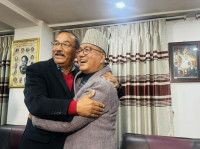Politics
How splits in parties may affect provincial politics
If UML fell into minority in Province 1 and Bagmati, Oli, the once powerful prime minister with almost two-thirds majority support, will be reduced to a leader of the party that lost all the governments in Kathmandu and provinces.
Tika R Pradhan
The electoral alliance between the CPN-UML and CPN (Maoist Centre) in the 2017 elections paid off in six of the seven provinces. Subsequently, it was agreed that the UML would lead the government in four provinces and the Maoist Centre in two. The two parties eventually merged in May 2018 and became Nepal Communist Party (NCP).
But on March 7, the Supreme Court invalidated the Nepal Communist Party (NCP) and revived the UML and the Maoist Centre. Last week, the UML also broke into two, with Madhav Nepal applying for a new party–CPN (Unified Socialist).
The split now can have an impact on Province 1 and Bagmati, as governments could collapse there anytime.
On Wednesday in Bagmati, as soon as an ordinance to amend provisions on party split was promulgated, Ashta Laxmi Shakya, who was with the Nepal faction, was appointed chief minister, replacing Dor Mani Poudel. But with the rise of the Congress-Maoist Centre alliance, backed by the Nepal group and Janata Samajbadi Party, Shakya’s position could be in danger anytime soon.
“Our alliance will form a new government if the newly-appointed chief minister remains with the UML as some assembly members have already supported Madhav Nepal’s party,” said Shalikram Jammarkattel, a Maoist Centre leader and assembly member.
In the 109-strong Provincial Assembly in Bagmati, the UML had won 56 seats. Eight members were from the Nepal faction, which has not applied for a new party. For Shakya to save her government, she will need the support of 55 members. If she sticks with the UML, she might have to step down. The only way she can save her government is by joining the Nepal faction so as to secure the support from the Maoist Centre (23 seats) and Nepali Congress (22 seats).
“We will wait until the Election Commission registers the new party,” said Jamarkattel who is also the Parliamentary Party leader of the Maoist Centre. “If Shakya joins our alliance we will support her.”
In Province 1, where the UML had won 51 seats, Chief Minister Sher Dhan Rai could face an ouster, as 15 are from the Nepal faction. This is the only province where Oli’s confidante is in power.
In Lumbini, Oli’s yet another right hand, Shanker Pokhrel, was replaced on August 12 by Kul Prasad KC of the Maoist Centre on August 12.
Like Shakya in Bagmati, Oli was preparing to replace Rai with Bhim Acharya, the party secretary.
“Sensing that he won’t remain chief minister for even a month if appointed by Oli, Acharya has now been lobbying with Nepal to become chief minister,” said Rajendra Rai, a provincial assembly member close to Nepal. “We will have to share the provincial chief and chief minister with Nepali Congress. Let’s see what happens after our party is officially registered.”
In Gandaki, Oli lost his confidant Prithvi Subba Gurung in June after Nepali Congress’ Krishna Chandra Nepali Pokharel replaced him.
The only province that is likely to remain unaffected amid the fast-changing politics in Kathmandu is Province 2.
It was the only province where the UML-Maoist Centre’s electoral partnership could not win enough seats. The Rastriya Janata Party (RJP) and Sanghiya Samajbadi Forum Nepal had won a majority and formed a government. The Sanghiya Samajbadi Forum Nepal was later named Sanghiya Samajbadi Party (SSP) after its merger with Baburam Bhattarai’s Naya Shakti.
The RJP and SSP had merged in April last year, but it has also now split into two, with Mahantha Thakur applying for a new party–Loktantrik Samajbadi Party Nepal. Thakur’s party now controls around a dozen seats in Province 2 Assembly, but the number is not clear yet.
Of the 21 seats won by the UML, 13 are with Nepal and eight, including Satya Narayan Mandal, are with Oli.
If more than eight members of the total 55 members of the Janata Samajbadi Party in the provincial assembly defect to Thakur’s Loktantrik Samajbadi Party within 21 days after the party is duly registered, Mandal will become the leader of the main opposition party.
In Karnali and Sudur Paschim, the Maoist Centre controls power, with its leaders
Mahendra Bahadur Shahi and Trilochan Bhatta as chief ministers, respectively.
In the case of Shahi, his chief minister’s seat was saved after four of the Karnali provincial assembly members close to the Nepal faction sacrificed their assembly seats.
Out of 40 members in the Karnali assembly, one member from the Maoist Centre and four from the UML were removed from their parties, thus reducing the number of assembly members to 35. With 12 members from the Maoist Centre and six from the Nepali Congress supporting him, Shahi is in a comfortable position.
In Sudurpaschim, too, the UML infighting has strengthened the Maoist Centre’s position. As many as 18 members of the UML faction close to Nepal had recently voted in favour of Bhatta.
Experts on federalism say Oli through his misadventures not only weakened himself and his UML party but also caused troubles in provinces which were trying to stand on their feet.
“At a time when provinces were to focus on development works, they were forced to spend their time saving and making their governments,” said Khimlal Devkota, an expert on federal affairs and a member of the National Assembly.




 9.12°C Kathmandu
9.12°C Kathmandu















